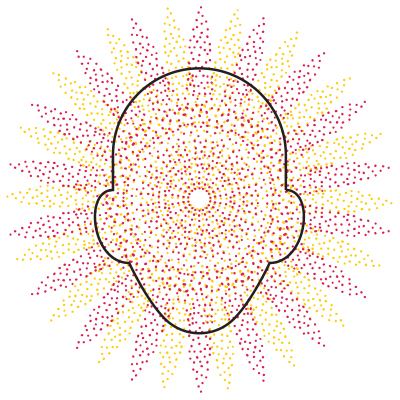
For patients with brain tumors, the route to the radiation room can be anxiety-producing — particularly the first time, when they go to be fitted with a moldable, plastic mesh mask that will anchor their head in the same position each time they receive radiation therapy.
Annie LaVigne, chief resident in radiation oncology at The Johns Hopkins Hospital, has thought a lot about her patients. To lift their mood, she envisions them being greeted along the corridor by unique wall hangings: mesh masks-turned-art projects. “To make the process less anxiety-producing, I want to ground these foreign objects in something familiar to our patients,” she says, “something we share in common that’s unrelated to cancer, like Old Bay and crabs and the Ravens.”
This ongoing project, now funded through the Barbara and Peter Miller Scholars Personomics Initiative, began when LaVigne was a fourth-year resident and a scholar in the yearlong Health Humanities distinction track for residents and fellows at The Johns Hopkins Hospital and Johns Hopkins Bayview Medical Center. “In college, I minored in studio art, but I didn’t have much time for it once I started residency,” she says. “The track helped me find my way back to my art and connect it with improving patient care.”
A key pillar of the Health Humanities distinction track is an inquiry-based teaching method known as visual thinking strategies (VTS), which asks learners to observe and discuss visual art. The idea is to build participants’ ability to describe, analyze and interpret imagery and information, and to have them engage in collaborative discussions, which is all aimed at developing critical thinking skills.
At Johns Hopkins Medicine, psychiatrist Meg Chisolm, a member of the Miller Coulson Academy of Clinical Excellence, is a leading advocate of this approach. She says VTS gave her dramatically new ways of thinking and changed the entire course of her medical career, as she pivoted from directing Johns Hopkins’ Center for Addiction and Pregnancy to become associate director of the Paul McHugh Program for Human Flourishing, whose mission is to help clinicians practice in a more humanistic way.
“What I have come to care about most in life is art museum-based medical education,” says Chisolm, vice chair for education for the Department of Psychiatry and Behavioral Sciences. “I’ve seen its power to cultivate a sense of wonder about oneself and one’s patients, resulting in physicians who are able to deliver more humanized care.”
“What I have come to care about most in life is art museum-based medical education. I’ve seen its power to cultivate a sense of wonder about oneself and one’s patients, resulting in physicians who are able to deliver more humanized care.” – Meg Chisolm
As an example of the VTS approach, Chisolm describes a popular class she developed for medical students, called Professional Identity Transformation: An Art Museum-Based Elective.
She always begins the first class with this prompt: “Pair up. Then, choose a work of art with which to introduce yourself to your partner. After you exchange introductions, introduce your partner to the rest of the class.” Chisolm says the exercise requires students to listen attentively to their partners, and it replaces dry, formulaic introductions with ones like: “This painting reminded me of the old trumpet my father had, which inspired me to learn to play. In college, I ended up being in the marching band, which is where I met my best friend and my husband.”
“These art museum-based methods support skills important to physicians, like observation, communication, critical thinking, tolerance of ambiguity, comfort with uncertainty and personal insight.” – Meg Chisolm
In a field rife with the competitive acquisition of knowledge, where students spend years sharpening their individual acumen, Chisolm says this course increases a sense of community and reteaches the value of collaboration and teamwork.
One former student wrote, “It was amazing how someone else would point out something that I had completely missed in studying the same picture or poem.” And another noted, “Since I was young, I have always been afraid to answer questions in class because I did not want to get them wrong, but this class allowed me to express my thoughts without that kind of fear.”
“These art museum-based methods support skills important to physicians, like observation, communication, critical thinking, tolerance of ambiguity, comfort with uncertainty and personal insight,” says Chisolm, who has used VTS and other arts-based teaching methods with Johns Hopkins pre-health professions students, residents/fellows and faculty members, in addition to medical students.
She’s found the course can also help learners process the strong emotions and stressors that arise during training and medical practice. “The class helped me interrogate my feelings about my career in medicine and about patient experiences I had had,” says fourth-year medical student Diane Jung. “It gave me time and space to reflect on why I wanted to go into medicine and to realize I still had hope and found purpose in my future as a physician.” — Catherine Gara